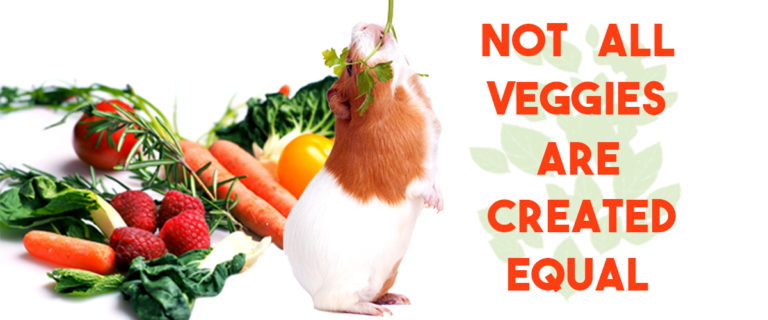Veggies are supposed to be healthy, so why are guinea pigs giving some a bad rap? There are a lot of charts, lists, and diet plans out there, but the secret recipe for a healthy diet is all about balance and moderation. There are no “good” or “bad” vegetables. Fresh foods just have different levels of nutrients that guinea pigs may need in larger or smaller amounts at various life stages. You don’t need to become a chemist or mathematician to whip up your guinea pig’s veggies, but it helps to know what you’re working with at the supermarket.
Vitamin C
Guinea pigs and primates, like us, are unable to make their own vitamin C. Because their bodies can’t synthesize or store it, they need to receive around 25 mg per day on average through their diet. Guinea pigs that don’t get enough vitamin C are at risk for scurvy and more prone to illness. Offering a cup of guinea pig veggies (fresh daily, of course) will likely be your cavy's fave way to meet the requirement.
High in Vitamin C
- Bell Peppers
- Parsley
- Spinach
- Kale
- Broccoli
- Mustard Greens
- Dill Weed
- Kohlrabi
Low in Vitamin C
- Cucumber
- Corn
- Celery
- Carrots
- Lettuce
- Escarole
- Squash
Sugar
Too much sugar can cause digestive trouble in guinea pigs, much like it can for us. Guinea pigs’ gut flora is very carefully balanced. Too much sugar can allow the “bad” bacteria in the gut to take over. This can lead to soft stools, bloat, and even gastrointestinal infections.
Foods high in sugar can also make for one fat pig if fed too often. As you’d probably guess, fruits tend to be high in sugar. A few extra pieces of fruit can help a recovering, underweight guinea pig put on weight, but shouldn’t be a normal feature on the everyday menu.
Vegetables like beets, carrots, tomatoes, and even red peppers are also high in sugar. Don’t worry if peppers are your daily go-to for vitamin C. Rotate in some of the other colors throughout the week to balance out the sugar content while still providing plenty of vitamin C.
Calcium
Calcium is probably the most misunderstood and controversial mineral when it comes to feeding guinea pigs. While we know that diets too high in calcium can lead to bladder stones, the trendy low-calcium diets have proven that too little calcium in the diet can cause bone and dental problems. Balance is key.
Guinea pigs absorb more calcium from their food than humans do – around 50% on average. If calcium isn’t absorbed by the body, it travels through the kidneys and bladder to ideally be excreted in the urine. Excess calcium can hang out in there and bond with other minerals to form stones. Older guinea pigs don’t absorb calcium quite as effectively as the youngsters, so a balanced diet becomes extra important (sorry, alfalfa).
High in Calcium
- Spinach
- Parsley
- Arugula
- Dandelion Greens
- Turnip Greens
- Kale
- Dill
Low in Calcium
- Tomatoes
- Cucumber
- Carrot
- Bell Peppers
- Radicchio
Oxalic Acid
Oxalates can bind to calcium and reduce its absorption, which can lead to stones if foods high in oxalates are fed too much. Oxalic acid content tends to go up as food matures, so young veggies are less likely to have high oxalic acid content.
High in Oxalic Acid
- Parsley
- Spinach
- Sweet Potato
- Beet Leaves
- Swiss Chard
Low in Oxalic Acid
- Corn
- Cilantro
- Kale
- Cucumbers
- Squash
- Bell Peppers
- Endive
- Parsnip
- Tomatoes
Ca:P Ratios
If only it were as easy as sticking to low-calcium guinea pig veggies. Vitamin D (sunlight! 
The ideal Ca:P ratio for guinea pigs is 1.33:1 from the whole fresh diet. This means if you’re feeding foods with less calcium than phosphorus (like carrots, cucumber, sweet potato, and romaine lettuce) you need to also feed foods with the inverse ratio to balance things out (like cilantro, swiss chard, kale, green/red leaf lettuce, celery, and okra). This can reduce the chances of stones developing and may even be beneficial for overall kidney health.
To find the Ca:p ratio of a certain food, divide the calcium amount by the phosphorus level. For example, 40 grams of pumpkin has 8 mg of calcium and 17 mg of phosphorus, so has a Ca:P ratio around 0.5:1 (8 divided by 17). If you’re feeding multiple foods, add all the calcium numbers up, then add the phosphorus numbers, and finally divide both by the total number of foods. Make sure you’re calculating ratios based on equal quantities (weight or calories).
Example:
1. Parsley – Ca:P ratio of 2.4:1
2. Bibb lettuce – Ca:P ratio of 1.4:1
3. Squash – Ca:P ratio of 0.7:1
4. Green bell pepper: Ca:P ratio of 0.5:1
Total calcium (5) divided by number of foods (4) = 1.25
Total phosphorus (4) divided by number of foods (4) = 1
Ca:P ratio for this piggie platter is 1.25:1 … pretty good!
Overwhelmed?
Who knew feeding guinea pigs could be so complicated? Veggie time is supposed to be fun, not stressful, and you don’t need a degree in algebra to do it. While Guinea Lynx has a handy calculator you can use to balance your guinea pig’s veggies, you don’t need to measure to a tee every day unless your guinea pig has a chronic health issue. Focus on providing variety and follow these five simple rules:
1. Aim to provide veggies high in vitamin C (bell peppers daily are great).
2. Avoid feeding high-calcium produce in large amounts or too often.
3. Make sure your overall diet doesn’t have more phosphorus than calcium.
4. Limit vegetables that are high in oxalic acid.
5. Reserve sugary foods for special treats.












